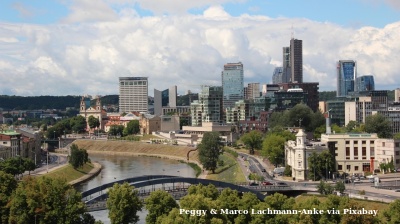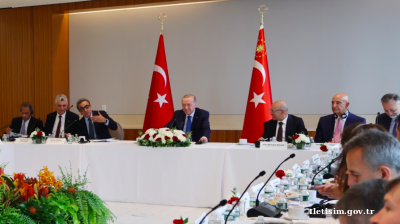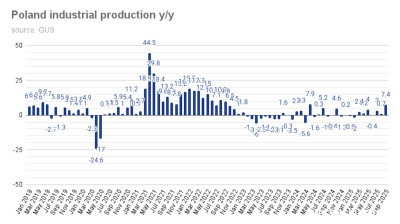Russia’s economy put in faster than expected growth in the second quarter of this year, posting 10.3% y/y, according to preliminary data released by Rosstat on August 17.
Russia’s GDP was up 1.3% vs. 4Q19, although it is still 3 percentage points below pre-COVID-19 trend levels. Previously the Central Bank of Russia (CBR) said that the economy had caught up with its pre-COVID levels in the first half of this year after growing 4.6% in the first six months of the year.
“Going into 2H21, we expect growth to slow to 0.7% SA q/q in 2H21, the same rate as in 2018-19, which is still better than the long-term potential (2% y/y, or 0.5% SA q/q),” Sova Capital said in a note.
“As a result, we expect GDP to grow 5.2% y/y in 3Q21 and 4.6% y/y in 4Q21, and we forecast a FY21 growth rate of 4.8% y/y, which is better than the recently revised CBR projection (4-4.5% y/y) and our previous estimate of 3.4% y/y,” the analysts added.
The latest growth rate of 10.3% y/y was better than Sova Capital’s forecast (9.6% y/y) as well as the market consensus (10% y/y) and Ministry of Economic Development (10.1% y/y) expectations.
The estimate is based on the production approach, which uses data from large and mid-sized enterprises in the non-financial sector.
According to Rosstat, which disclosed no additional details, the 2Q21 GDP estimate was largely influenced by the rebound in almost all industries, with manufacturing up 11.4% y/y, construction up 10.7% y/y and mining and quarrying up 7.8% y/y, Sova Capital reported.
Both wholesale and retail trade showed significant accelerations to 19.8% y/y and 23.5% y/y, respectively, while freight and passenger turnover picked up 9.9% y/y and 250% y/y, respectively.
“GDP was up 1.3% in 2Q21 vs. 4Q19, and the q/q growth rate appeared to be much stronger than in 1Q21 and 4Q20 at 2.2% SA q/q vs. 0.9% SA q/q in 1Q21 and 1.2% SA q/q in 4Q20. However, the economy is still 3ppts below the pre-COVID-19 level of 0.55% SA q/q (the average for 2017-19),” Sova Capital said.
“The results appeared to be better than we expected, and we will be able to single out the best performing sectors once more details are available on 10 September (i.e. the first estimate with a production breakdown). We believe that financial services could have performed well, as it saw an acceleration in credit dynamics in anticipation of the tapering of the subsidided mortgage programme. We also expect a better performance from services related to tourism, as most outbound tourist destinations (e.g. Turkey and Egypt) were closed,” the bank added.
As the economy passes the contraction gap caused by the lockdowns last years, most analysts and the CBR expect the momentum to ease in in the second half of this year.
Consumer activity – currently the main economic driver, fuelled by excess savings, a lack of outbound tourism and the growth of real income – should normalize as Russians use up their excess savings and as outbound tourism restarts, especially to Turkey and Egypt. Finally, the tapering of the subsidised mortgage program and a tighter monetary policy should offset elevated consumption and credit demand, Sova Capital predicts.
“Support for consumption should come from stronger incomes, which still have room to improve vs. pre-COVID-19 levels (disposable incomes are still 0.8% below 2Q19). We also expect a further recovery in the energy sector amid OPEC+’s easing of production constraints and greater activity in the services sector as the third wave of COVID-19 fades,” Sova Capital said.
“Going into 2H21, we expect growth to slow to 0.7% SA q/q in 2H21, the same rate as in 2018-19, which is still higher than our estimate (2% y/y). As a result, we expect GDP to grow 5.2% y/y in 3Q21 and 4.6% y/y in 4Q21, and we forecast an FY21 growth rate of 4.8% y/y, which is better than the recently revised CBR projection (4-4.5% y/y) and our previous estimate of 3.4% y/y,” the bank concluded.
Data

Hungary’s central bank leaves rates unchanged
National Bank of Hungary expects inflation to fall back into the tolerance band by early 2026, with the 3% target sustainably achievable in early 2027 under the current strict policy settings.

Germany slowdown weighs on Lithuania’s export-driven manufacturing sector
Lithuania’s economy remains highly sensitive to the industrial cycle in Germany, its third largest trade partner.

Chobani yoghurt king Hamdi Ulukaya becomes richest Turk
Knocks Murat Ulker into second place in Forbes ranking as his company's valuation leaps to $20bn.


